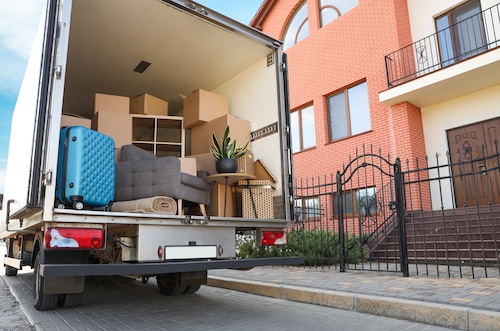The average cost to move cross-country (and how to save money)
Contributed by Tom McLean
Sep 19, 2025
•6-minute read

With remote work on the rise and the high cost of housing, more Americans are moving long distances to find affordable homes. Relocating can be time-consuming and costly, depending on where you’re moving and what you need to move. How much does it cost to move across the country? Learn more about your choices and what effect they have on the cost of moving cross-country.
How much does it cost to move cross-country?
Depending on the company you hire and the method of transportation you choose, the average cost to move across the country is about $4,572, with most people spending $2,391 – $6,868, according to HomeAdvisor/Angi . The price tag for a coast-to-coast move is about $10,300, Angi reports.
Your home size is a significant factor in how much a cross-country move costs. Moving costs range from $700 – $3,000 for a studio or one-bedroom home, $1,000 – $7,000 for two bedrooms, $1,400 – $8,000 for three bedrooms, $1,800 – $10,000 for four bedrooms, $3,000 – $12,000 for five bedrooms, and $4,000 – $15,000 for six bedrooms, per HomeAdvisor/Angi.
Movers usually provide an estimate of the total cost to move you cross-country. Remember that this is an estimate, and the final price may differ.
The more work you do up front, including accurately inventorying and tracking which specific items you’ll be moving, the more accurately you budget and manage your cross-country moving costs.
6 factors that determine how much it costs to move cross-country
Several variables – including distance, transportation method, time of year, and hiring professional movers versus DIY – determine how much it will cost you to move cross-country.
1. Mileage
Naturally, moving into a new home will cost more the farther it is from your starting point.
If you’re hesitant to hire a moving truck and professional movers, rental trucks can be a cost-effective way to move your belongings, generally costing $1,200 – $2,100. Renting a moving truck can set you back between $20 a day for a local move and $5,300 at the high end. Companies like U-Haul rent trucks for a flat fee for longer distances, but they may charge about $1 for each additional mile. Long-distance moves generally bundle mileage into the truck rental cost, while local moves charge roughly $0.75 or so per mile. Note that while do-it-yourself moves and moving truck pickups can save you money, you’re doing all the work, and it may take more time than hiring movers.
2. Method of transportation
You also need to choose transportation for your belongings. It’s usually done by truck, but depending on where you’re moving, you may also have the option to ship by air or a container loaded on a ship.
You also can rent a pod or movable storage container that’s dropped off at your residence. You pack up the pod, and it’s later picked up and transported by a moving company to your new home. Costs range from $220 for an 8-foot container on a local move to $7,448 for a 16-foot container on a long-distance move. Post-move storage fees start at $149 per month, plus there are average delivery and pickup charges of $75 each.
If you own a mobile home or a manufactured home that you’re moving, you also may be able to transport your belongings along with your entire residence by truck to a new location.
3. Using professional movers
Hiring professional movers and a moving truck is another common way to plan for a cross-country move.
Costs vary depending on the services you choose, from packing your belongings to simply picking them up for transport, as well as the individual moving service provider. You’ll often pay an hourly rate based on how many movers you need – two to four is typical – and how much labor the move requires. For example, it may take six hours to move a three-bedroom house versus eight hours for a five-bedroom home.
Hiring a moving company generally costs between a few thousand dollars and $10,000, according to Consumer Affairs . Get quotes from several moving companies and check their references before hiring one. And remember: Doing most, if not all, of the packing yourself is often a great way to save money.
4. Packing supplies
You’ll also need packing materials for your things. Some of the most common supplies long-distance movers and moving services use include:
- Bubble wrap
- Cardboard boxes
- Paper
- Dish crates
- Bankers’ boxes
- Moving blankets
- Plastic wrap
- Tie-down straps
- Plastic foam peanuts
- Plastic storage bins
Costs vary by region and retailer. It’s usually best to buy them yourself if possible, as they may cost more when purchased from the moving company.
5. Time of year
If you’re moving at a time of year when movers and moving trucks are in high demand, you can expect to pay more. For example, Sept. 1 in Boston is known as Moving Day because many leases in the city end and begin on that date, many of them for college students. Many families prefer to move during the summer because it’s easier to do so during warm weather, but it also means children are out of school. If you can choose when you move, a time when demand is low will save you time and money.
6. Additional services
Add-on services, such as packing, unpacking, furniture assembly, and storage, will increase the average cost of a cross-country move. They also make moving easier, and you may decide the services are worth the cost.
Optional moving services include:
- Packing assistance
- Unpacking or unloading assistance
- Furniture assembly or reassembly
- Moving specialty items, such as a piano or grandfather clock
- Removal of packing materials
- Use of a storage unit
- Wrapping and transporting fragile goods
- Moving insurance
- Additional moving personnel
8 ways to save money during a long-distance move
The following recommendations and best practices can help you save money on a cross-country move.
1. Downsize your household
Downsize and declutter your home before you start packing. Doing so reduces how much stuff you need to move, which may be a necessity if you’re moving to a smaller home. Common strategies for downsizing include holding a garage or yard sale, donating items to charity, or just plain throwing them away.
2. Find free packing materials
While boxes, paper, and bubble wrap can be somewhat expensive, you can avoid paying for them at all with a little legwork. Check with your local grocery or liquor store and ask if they have any empty boxes handy. Many online retailers, local dollar stores, and discount warehouses offer bubble wrap, cardboard boxes, and packing tape at volume discounts. The more creative and resourceful you are here, the more you can save on your cross-country move.
3. Ask for help from friends and family
Labor costs are a significant expense when moving across the country. You can save on labor by asking friends and family members to help pack and load your belongings. They may be happy to help you free of charge or in exchange for a meal and refreshments. Remember: Every hour of free help is an hour of labor you don’t have to pay for.
4. Pack your own boxes
You also can save money on the cost of a cross-country move by packing your own furniture and belongings. Not paying packers to box up your stuff can save you a significant amount of money. For example, a homeowner who uses a portable moving container that they pack themselves could save more than $1,000 as opposed to hiring two or three movers to help. As ever, DIY options remain the most cost-effective here.
5. Choose a less busy time to move
You may also be able to save money by scheduling your move during slower seasons, such as winter. Market prices fluctuate with supply and demand. Booking your move during the off-season, at a time when professional movers could use more business, can help you get a more competitive rate.
6. Get multiple moving quotes
Not all movers charge the same amount or offer the same services. Getting quotes from multiple moving services to compare will help you find the best deal. Take time to do your research and check customer reviews and references before picking a service. Remember, the cheapest option isn’t always the best, as customer service and support levels may vary.
7. Read the fine print
Some moving companies may charge extra or unexpected fees. It’s not uncommon to find clauses or sticking points in the fine print of a contract or estimates. You’ll also want to make sure the moving company is delivering what you asked for and charging you accordingly.
8. Ask for possible discounts
Some moving services offer discounts to senior citizens, students, teachers, or veterans of the Armed Forces, so it’s always worth asking moving companies about any discounts you may be eligible for. You also may be able to negotiate breaks on the overall price or costs for labor and materials. You’ll also want to catalog your belongings and provide a detailed inventory of what you plan to move. Doing so may help you better estimate the size of the job. If you realize you need only two movers instead of three, you can save money. You may also qualify for various moving assistance programs.
The bottom line on how much it costs to move cross-country
Moving across the country is a major undertaking. How much it’ll cost you depends on how far you’re moving, how much stuff you need to move, and how much help you want with packing and loading. Similarly, the time of year makes a difference, and what services you need also affect the price tag. Make sure to do your homework to figure out what you need to move, how much help you need, and when you need to move. Get estimates from movers and be sure to ask if you’re eligible for any discounts.
You can begin preparing for your relocation now by creating a moving checklist today.

Erik J Martin
Erik J. Martin is a Chicagoland-based freelance writer whose articles have been published by US News & World Report, Bankrate, Forbes Advisor, The Motley Fool, AARP The Magazine, USAA, Chicago Tribune, Reader's Digest, and other publications. He writes regularly about personal finance, loans, insurance, home improvement, technology, health care, and entertainment for a variety of clients. His career as a professional writer, editor and blogger spans over 32 years, during which time he's crafted thousands of stories. Erik also hosts a podcast (Cineversary.com) and publishes several blogs, including martinspiration.com and cineversegroup.com.
Related resources
7-minute read
How to relocate to another state: A step-by-step guide
Moving to another state can get complicated. That’s why you must prepare and plan. Follow our step-by-step guide to learn how to relocate to another state...
Read more
6-minute read
Buy and sell your home with trusted partners
Whether you’re looking to buy your first or your fifth home, it’s a tough market out there right now. Learn how we can support you.
Read more
6-minute read
Should I Move Or Remodel
If you’re unhappy with your current home, you have two options: renovate or move. This is a big financial and emotional decision, and The Red Des...
Read more